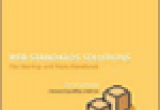 Web Standards Creativity is a fascinating look at how some of the best designers in the business use web standard compliant markup and CSS to take web design to new heights of style and function. Based on actual "case studies," it's also an intriguing look inside these designers heads. The decision-making process they reveal teaches us as much about good design as the methods they're describing.
Web Standards Creativity is a fascinating look at how some of the best designers in the business use web standard compliant markup and CSS to take web design to new heights of style and function. Based on actual "case studies," it's also an intriguing look inside these designers heads. The decision-making process they reveal teaches us as much about good design as the methods they're describing.
This book is not an exhaustive look at what is possible with CSS/HTML, nor does it try to be. It is a series of real-world design projects and problems, described by top-notch designers who found innovative, creative, accessible techniques and solutions.
The lineup is impressive, starting with Simon Collison, who takes us step-by-step through the redesign of the Dirty, Pretty Things site, and concluding with Derek Featherstone's formula for accessible "sliding doors" navigation. In the pages in between, Ethan Marcotte reveals some of the tricks and ingenuity that went into the complex redesign of the New York Magazine; Andy Clarke demonstrates how to create a wonderfully un-boxy design; Jeff Croft reveals some surprises about PNG transparency; Ian Lloyd takes us through his solution for printing sections of pages; and Cameron Adams discusses two clever ways of dynamically serving up different layouts for different resolutions.
My favorite chapters were Dan Rubin's account of creating a CMS site that doesn't look like every other template-based site—an issue I face daily, dealing with Drupal sites. Mark Boulton's chapter on using a grid for layout and design was equally inspiring and illuminating. And I thoroughly enjoyed Rob Weychert's chapter on typography because I love the historical aspect but also because I think it's an essential topic that all web designers should be well-versed in.
This book is for designers with some experience with CSS and HTML. It isn't a textbook on advanced CSS, but it will teach you about those subjects and more—design, process, decision-making, creativity and accessible web standards.


